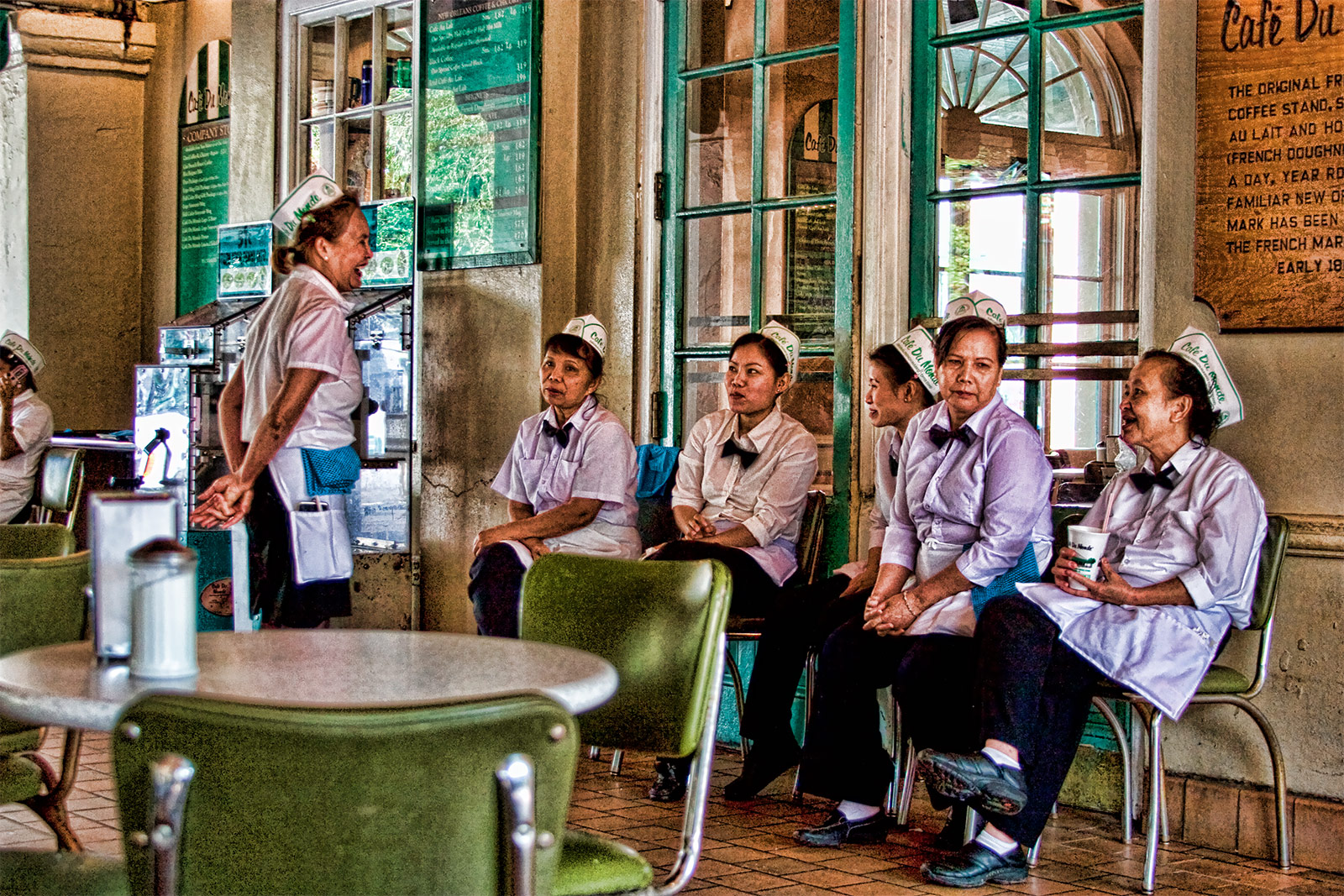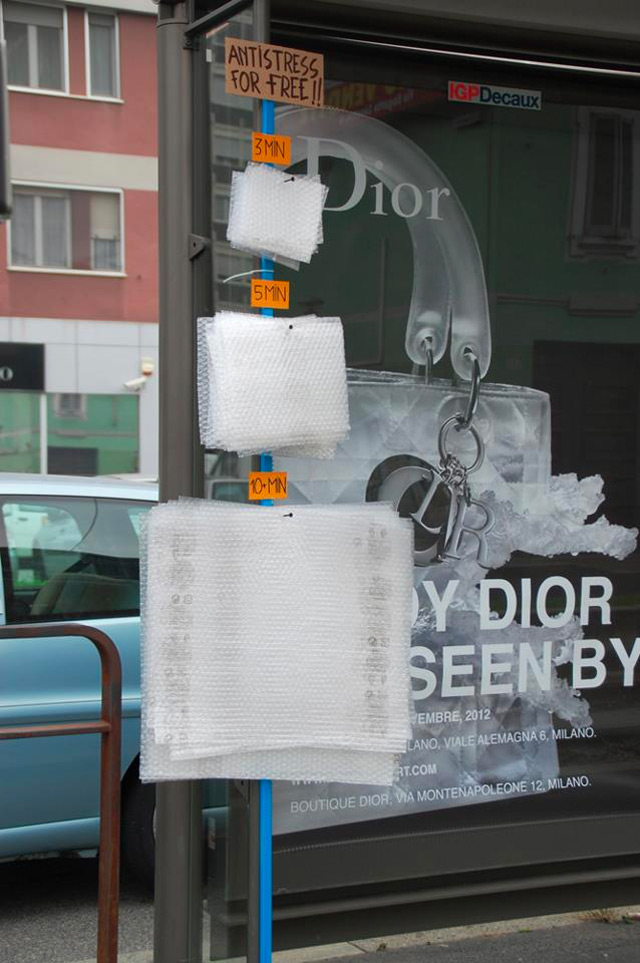
Waiting
Products are consumed, services are experienced
In all daily acts, we have tedious routines that we find it hard to get out of. Waiting for public transport is one of them. Today at a bus stop in Milan, the wait is going to be more fun. Today at our bus stop we find this:

Fuente: vandalog.com – Destress with free bubble wrap
Hanging on the wall we find squares of bubble wrap in three different sizes. Depending on your waiting time you can choose: three minutes, five minutes, or for longer waits, ten minutes. A sign informs us of their use and price: “Antistress for free!!”.
You know what you have to do, right? Calculate your waiting time. Choose a size of bubble wrap that fits your wait and start with the “when you’re popping, there’s no stopping.” Now you don’t remember how boring it is to wait for the bus to arrive. Now you have something fun to fill your time with.

Fuente: vandalog.com – Destress with free bubble wrap
This brilliant idea from Italian artist Fra.Biancoshock plays with the psychological principle known as “Occupied Time Feels Shorter Than Unoccupied Time”. Waiting is part of our lives. We do it all the time: at a bus stop, when paying in the supermarket, when we are in a restaurant, when loading a new page in the browser…
The wait is one of the key factors when remembering an experience positively or negatively. Given that the memory of an event is more important than what really happened during the experience, we can imagine how important it is to bear in mind the wait and its design in any process of defining a product or service.
Lines or queues have been studied within marketing, operation design and organizations. Traditionally, the approach to these studies has placed the focus on the efficiency of the queues and on theorizing mathematical models: Queueing theory, which predict the length of a queue and the waiting time on it. What is the best way to serve customers, at the lowest cost?
In general, the user’s experience is undervalued as a goal for improvement regarding lines or queues. The progress of these focuses on values such as the time associated with the wait, which, although important, is not a determining factor for a user’s satisfaction or dissatisfaction.
In the commerce world, it is known or calculated how many sales assistants are necessary to hire for the number of clients expected for a service, how they are distributed at stations, the average number of clients that can be served per station and the average time needed to serve each one. In this post, I would like to focus on the waiting experience, its fundamental principles and their application to designing services and products.
Emotions Dictate Our Experiences
Emotions are the key to a good experience. When you are in a good mood, experiencing minor setbacks does not mean a big problem. Having these same small setbacks in a state of anxiety or irritability is crucial to judging an experience as negative and not wanting to repeat it.
Objective number one: Overcome and change the negative emotions of customers who are dissatisfied with the wait. For example, Disney considers lines to be a part of the rides themselves. Therefore, its employees who are dressed up as cartoon characters focus their attention on queues and are specially trained to deal with customers who are dissatisfied with these queues. Emotions are contagious. Having happy people around you makes you happy. You can imagine the opposite case, right?
Understanding How They Work
Extremely important for a good experience on a line is understanding how it works. For example, not distinguishing between different types of lines—fast, with few items, home delivery, etc.—causes misunderstandings for users who simply see a line and wait. Realizing later that we are on the wrong line is not the most pleasant of feelings. The environment must provide unmistakable indications of the different types of lines, their function and their estimated waiting time.
Informing of and explaining the changes that might take place during the wait is also fundamental. Not knowing what is happening, not informing of problems, only leads to users’ frustration and unhappiness. Imagine you are in the waiting room of a hospital ER. The distressing part of the process is the lack of information. Feedback from doctors is more important than the waiting time we face.
If you have an appointment with your doctor and you are told that he will be delayed half an hour, you will experience initial anger, after which the wait will be bearable. You know what’s happening, and they have set new expectations of when your wait will end. The anxiety has disappeared.
The Paradox of Choice
Having to pick a queue is a hard decision for users. Choosing one option always means rejecting others. The cost of opportunity is always high. Barry Schwartz puts it better:
“The cost of a missed opportunity subtracts from the satisfaction we get out of what we choose.”
It’s impossible for us to shake the feeling that the other queues are moving faster than ours. “The grass is always greener on the other side”.
People Want to Start Right Away
When you arrive at a restaurant, the first thing you’re offered is the menu. After a while, they will ask you about drinks, then they will offer you appetizers, etc… All these elements are time filters to convince you that the service has started from the very moment you entered the restaurant. Pre-waiting time is perceived as longer than the waiting processes once we have ordered.
When we get to a packed bar and try to order a beer from the bartender, our level of anxiety is much higher in the period of time we use to get his attention and order. Once we have ordered, our level of anxiety goes down. We no longer mind that the waiting time until we get the beer in our hands is longer.
Social Justice Begins in the Supermarket Queue
In situations where there is no visible order on the queue, imagine yourself in the middle of a crowd waiting for the subway. Stress levels are higher than in prioritized processes. “First in, first out.” Now imagine a line at a bank or at the boarding gate of a Ryanair plane (yes, I went there). The people waiting for the subway are anxious to keep their place on the line based on when they arrived. The people on line at a bank know that the processing order will be observed by order of arrival, and their frame of mind adjusts to this reality. The waiting time will be perceived as appropriate and fair even if it is longer.
Another problem regarding the feeling of being treated fairly arises when the people at the cash registers or serving the public have to carry out parallel tasks: answering the phone, chatting with other employees, going out to enjoy a break in sight of the people on line. It is then when users find the waiting time unfair, and they rebel against it. Dear civil servants, go out to have your coffee, but be smart and do it by the back door of the building.
Occupied Time Feels Shorter Than Unoccupied Time
If you have something to do during your waiting time, no matter how silly the activity, the perceived waiting time will be drastically reduced. When people have nothing to do while on a queue, the perception of waiting time increases by an average of 36%.
Proposing something as absurd, but addictive, as popping bubble wrap at a bus stop is understanding waits as part of the service itself that must be designed. Products are consumed—services are experienced.
Sources
- Krulwich Wonders: What To Do When The Bus Doesn’t Come And You Want To Scream. An Experiment Author: Robert Krulwich
- Destress with free bubble wrap Author: Caroline Caldwell
- The Psychology of Waiting Lines(PDF) Author: Donald A. Norman
- Queueing theory Author: Wikipedia
- Design principles and improved layouts for queue lines Author: James Robert Watson
- Justice — Wait for It — on the Checkout Line Author: Carl Bialik
- The Psychology of Waiting Lines Author: David Maister
Follow @NoamMorrissey Tweet